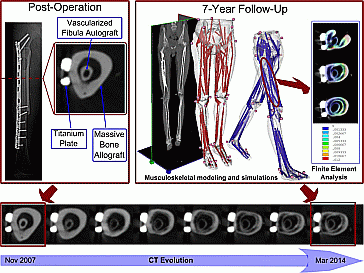ICCBH2015 Poster Presentations (1) (201 abstracts)
Extreme, biomechanically-explained remodelling of biological femoral reconstructions in pediatric oncology
Fulvia Taddei , Giordano Valente , Sabina Piroddi , Enrico Schileo , Lorenzo Pitto , Andrea Roncari , Alberto Leardini & Marco Manfrini
Istituto Ortopedico Rizzoli, Bologna, Italy.
Introduction: Vascularised fibula autograft combined with a massive bone allograft (Capanna 2007) is used in skeletal reconstructions in children. If vascularisation is successful a clear remodelling of the reconstruction can be observed. This study aims to define a protocol to characterise bone’s structural evolution in skeletal reconstructions through a computer-aided analysis, and attempts a biomechanical interpretation of the observed phenomena through a multiscale model. This was applied to a paradigmatic case (femoral reconstruction, 7 years follow-up without revision surgery) that showed dramatic remodelling.
Methods: Eight CT datasets of the child (8 years at operation for Ewing’s sarcoma) during follow-up were available. The evolution of bone morphology, density and inertia moments was quantified. At the last control, a gait analysis was performed. Muscle and joint contact forces were calculated with personalised musculoskeletal model (Figure 1) (Valente 2014), and used as inputs to calculate bone and plate safety factors, and bone remodelling stimuli with a validated CT-based finite element model (Schileo 2014). Different screw-removal configurations to reduce the stress-shielding were simulated.
Results: The geometry and density of the allograft changed dramatically during follow-up, towards a reorientation of the inertia tensor of the reconstruction to that of the contralateral femur. The overall safety of the reconstruction was not challenged (safety factor ≥3). However further bone resorption is foreseen because extremely low values of the bone remodelling stimuli were found. Only a complete removal of the proximal screws could restore a physiological, contralateral-like bone strain configuration.
Conclusion: We successfully quantified load-induced bone remodelling. The extreme remodelling pattern was explained by the multiscale biomechanical model, which raised concerns for the long-term adaptation.
References: Capanna, Orthop Clin North Am. 2007.
Schileo, J Biomech 2014.
Valente, Plos One 2014.
Disclosure: The authors declared no competing interests.

Figure 1




